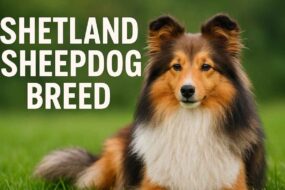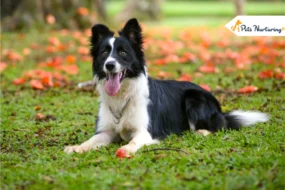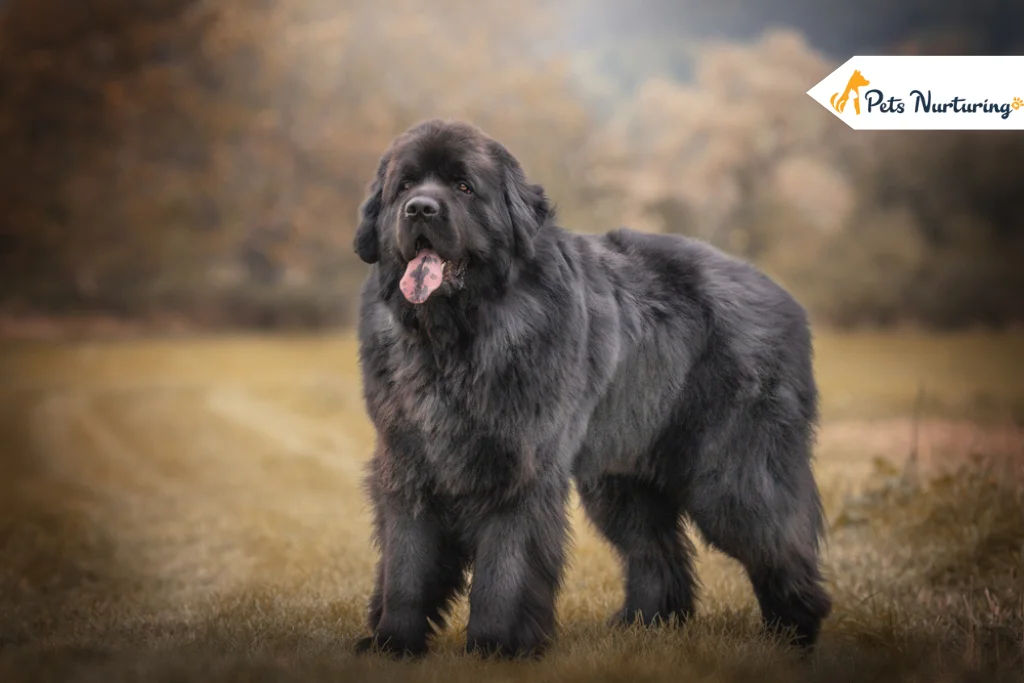
A loving, easy-going, sweet and loyal family dog with a majestic and bear-like appearance. The Newfoundland is a big, sweet dog that loves kids and is known for cute facial expressions. You might recognize them from Nana, the nanny dog in Peter Pan. While they might not babysit like Nana, they are really loving and protective of children.
Originally from Newfoundland, Canada, Newfoundlands are smart, friendly, and adaptable. Weighing about 100 pounds, they’re considered a giant breed and need regular exercise to stay healthy.
Newfoundland dogs love water and are excellent swimmers. Many stories tell of them rescuing people from cold water, like in shipwrecks or saving kids. They’re brave and heroic. Whether they’re working or just hanging out with you, Newfoundlands are amazing dogs. Their natural qualities, along with their size and strength, make them a breed worth loving and taking care of.
Want to know more about this dog? Keep reading our guide.
Breed Overview
The Newfoundland dog is one of the biggest dog breeds that’s both hardworking and gentle. People often call them “Newfie.”
They’re smart, sweet, and very loyal. These dogs are great companions, and they love doing jobs, especially ones in the water.
They were made for life on the water, with their thick fur keeping them warm and webbed paws helping them swim.
Newfoundland Dog Overview
Breed Group: Working
Height: 26 inches (female), 28 inches (male)
Weight: 100 to 120 pounds (female), 130 to 150 pounds (male)
Lifespan: 9 to 10 years
Coat: Thick, water-resistant double coat
Color: Black, brown, gray, and white with black markings
Temperament: Gentle, sweet, loyal, hardworking
Needs for Grooming: Regular grooming required
Hypoallergenic: No
Origin: Newfoundland, Canada
History
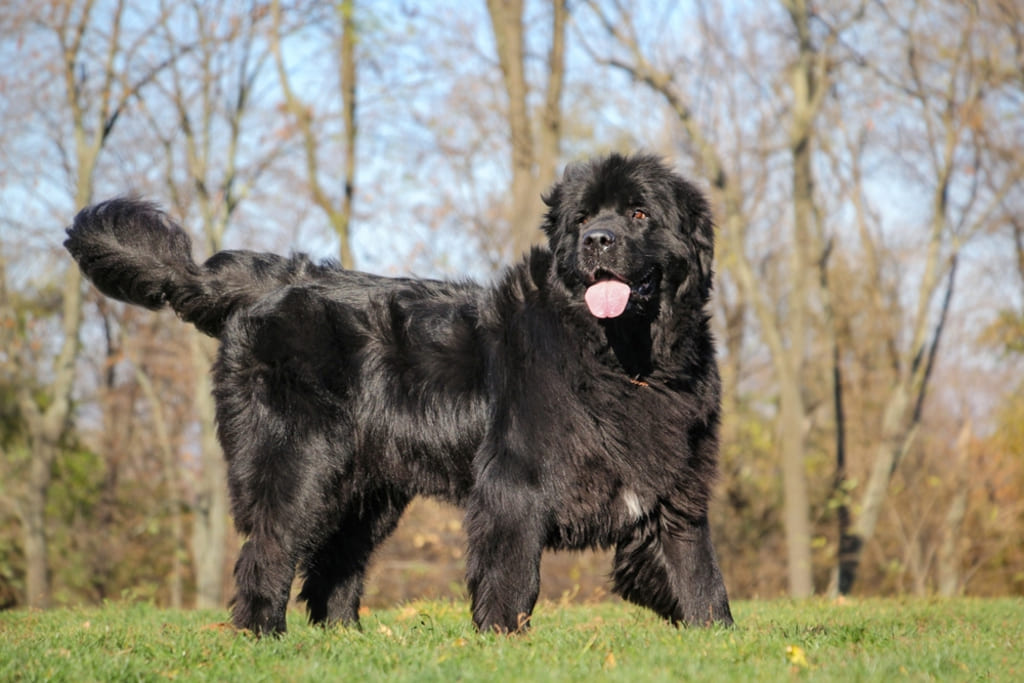
Newfoundland dogs, originally from Canada, have a natural love for water. Some people think that European fishermen mixed their dogs, like maybe a Great Pyrenees, with the ancestors of Newfoundlands.
Even though we’re not exactly sure where they came from, many believe they’re a native North American breed, maybe developed by the Algonquin and Sioux peoples.
Genetic analysis shows that Newfoundland dogs are connected to the Irish Water Spaniel, Labrador Retriever, and Curly-Coated Retriever. Originally, people in Newfoundland reared and used Newfoundlands as laboring dogs for fishermen.
Back in 1775, a trader named George Cartwright gave them the name “Newfoundlands.” These dogs were born to work – hauling nets for fishermen, moving wood around ports, and even working as water rescue dogs, says the Heart of America Newfoundland Club.
In the earlier 1880s, explorers from England and Ireland went to the Grand Banks of Newfoundland and found two classifications of working hounds. One was big, with a long coat (called the greater Newfoundland), and the other was medium-sized and active, with a smooth coat (called St. John’s Water Dog or the lesser Newfoundland).
The St. John’s Water Dog later became the first breed of contemporary retrievers. Both types of dogs worked hard, pulling fishnets, and the greater Newfoundland also hauled carts and gear.
Some think that the original Newfoundland dog on the island was smaller. The idea is that this smaller type mixed with mastiffs when sold to the English, and the English version became what we now know as the Newfoundland today. The American Kennel Club gave them the nod in 1886.
What’s cool about Newfoundlands is their amazing swimming skills. They don’t just paddle; they actually do a breaststroke. This unique ability helped them save lives by grabbing drowning people and towing them back to shore, facing up so they could breathe. Lifeguards in England and Wales used to have Newfoundlands as their must-have companions along the shores.
Some famous Newfies from history include Seaman, who joined explorers Lewis and Clark on their journey. Other cool Newfie owners were Emily Dickinson, Lyndon B. Johnson, Ulysses S. Grant, Robert F. Kennedy, bird expert John James Audubon and composer Richard Wagner.
Appearance
Newfoundland dogs have a striking appearance and a huge build, like a polar bear. They have amazing features like webbed paws and a coat that’s resistant to water.
Newfoundland dogs are big and strong. Males can stand as tall as 28 inches at the shoulder and weigh up to 150 pounds. On the other hand, females are a bit smaller, around 26 inches in height, and weigh up to 120 pounds.
| Attribute | Female | Male |
| Height | 26 inches | 28 inches |
| Weight | 100 to 120 pounds | 130 to 150 pounds |
They have sturdy, muscular bodies covered in a thick, water-resistant double coat that comes in different colors. The Newfoundland’s large bones and muscles give it the mass and power needed for rough ocean waves. The droopy lips and jowls make them drool, especially in hot weather.
In the water, Newfoundland dogs use their huge, webbed paws for maximum propulsion. Their swimming style is unique – a down-and-out motion that gives more power to every stroke, unlike other dogs.
Their eyes are deep and droopy, usually dark brown, and set above a wide muzzle, giving them a somewhat sad look. Their devoted expression invites frequent stroking of their long, soft ears.
Coat and Color
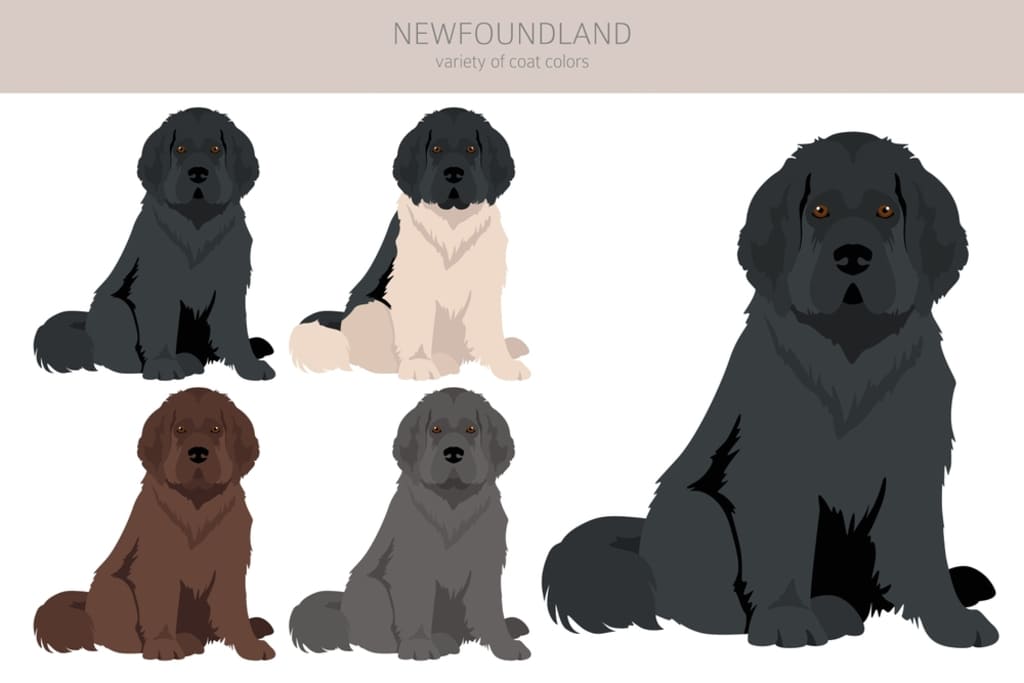
These dogs have double-layered coats that help them handle both cold and surprisingly warm weather. The outer coat is flat and coarse, providing insulation during swims in frigid water, while the undercoat is soft and plush.
The American Kennel Club recognizes black, brown, grey, and white-and-black as standard colors for Newfoundlands. Others are possible but not considered rare or more valuable. The “Landseer” pattern is named after artist Sir Edwin Henry Landseer and is featured in many paintings.
They have a thick, oily, waterproof double coat to handle icy waters, but it makes grooming a bit challenging and causes shedding. You can use vacuum for pet hair to keep your home clean if you have a Newfie.
Characteristics and Temperament
Mature Newfoundland dogs are known for their loyal, sweet, and easy-going nature. They handle various situations calmly, from children climbing on them to a bustling family room.
They’re happy to doze while life happens around them, and they enjoy being close to their people, even inclining against them or fibbing across their feet.
Despite their relaxed vibe, Newfoundland dogs are not lazy. They are eager-to-please and honest working dogs. In their hometown of Newfoundland, Canada, they aid with tasks like performing water rescues, retrieving fishermen’s nets, and hauling wood carts, as per the Newfoundland Club of America. They’re smart and react nicely to optimistic reinforcement, precise cues, and compliance training.
While they might let out a woof during playtime, a properly trained Newfoundland dog is a vigilant guardian. They bark as a caution to let you and others know they’re on duty to oversee their home.
Given their large size, subordination, crate and leash training are essential. Start training and socializing early, as Newfoundland has a prolonged period of adolescence. This early guidance helps with socializing and prevents unwanted behaviors like chewing, jumping, barking, and boredom.
Early socialization and training also ensure that your Newfoundland puppy interacts safely with kids. Since they grow nearly 100 pounds in the first year, they may not realize the impact of their exuberance. Right cues and optimistic commands strengthen good behavior.
Here’s an overview:
- Good with kids and pets
- Affectionate and friendly
- Very intelligent
- Moderate energy levels
- Medium exercise needs
- Doesn’t bark much
- Moderate shedding
- Medium trainability
Health and Nutrition

Newfies need a well-rounded diet to stay healthy. It’s a good idea to feed them commercial kibble or wet food that meets the standards set by the Association of American Feed Control Officials (AAFCO).
For healthy growth in New Foundland puppies, they need the right amounts of fat, protein, and carbohydrates. You can provide all these through AAFCO-compliant foods designed for giant and large-breed dogs. However, it’s always wise to consult your vet to determine the best diet for your pup.
When it comes to feeding adult Newfies, it’s generally recommended to feed them every 12 hours. Avoid using raised bowls, as they may increase the risk of bloat.
The amount of food to feed your Newfoundland dog depends on factors like size, metabolism, and activity level. Your vet and the feeding guide on your chosen dog food can help you determine the right quantity.
To enhance their nutrition, consider adding omega-3 fatty acids (DHA/EPA) to your Newfie’s diet. You can find these in skin and joint supplements, fish oil, and certain specially formulated dog foods. These fatty acids act as natural anti-inflammatories, supporting the coat, skin, joints, kidneys, and heart.
Make sure your Newfie always has fresh water available. Keep in mind that Newfies generally eat more than smaller dogs, so be ready for a higher dog food budget. You can also give them homemade raw or cooked food as per the vet’s advice.
Common Health Problems
Newfoundland dogs are generally healthy, but there are some health conditions to watch out for:
1. Gastric Dilatation-Volvulus (GDV)
This is a severe form of bloat that happens suddenly and needs immediate action.
It occurs when the stomach fills with food or gas, causing it to expand and rotate. Symptoms include retching, a swollen abdomen, drooling, and collapse.
Older dogs with deep chests, those fed from elevated bowls, and those fed only once a day are at a higher risk.
Quick veterinary intervention is crucial, and preventive measures can include a stomach-securing procedure during spaying or neutering.
2. Dilated Cardiomyopathy (DCM)
DCM is a heart condition that weakens the left ventricle muscle, leading to thinning.
Symptoms may appear suddenly or progress gradually, possibly resulting in congestive heart failure.
Intensive treatment is necessary, and not all dogs may fully recover. Regular veterinary check-ups are essential.
3. Bone Cancer (Osteosarcoma)
Newfoundland dogs are predisposed to this aggressive bone cancer. Lameness or limping is usually the first sign, and diagnosis involves X-rays. Treatment may include pain control, amputation, and chemotherapy.
4. Elbow Dysplasia
Elbow joint development is abnormal, often influenced by genetics, rapid growth, diet, or trauma. Symptoms include pain, limping, and lameness, similar to hip dysplasia. Treatment varies based on severity, with surgery often required.
5. Hip Dysplasia
This condition occurs when the hip joint doesn’t develop properly, leading to a loose joint.
Factors like growth rate, hormones, and diet can influence it, causing arthritis and pain.
Maintaining a lean body condition, low-intensity exercise, and supplements may help. Severe cases might need surgery.
6. Addison’s Disease
This serious condition happens when the adrenal gland doesn’t produce enough hormones. Signs include vomiting, poor appetite, lethargy, and severe shock. Diagnosis involves a series of tests by the vet.
7. Cherry Eye
Cherry eye is when the third eyelid gland swells, appearing as a red mass in the inner corner of the eye. Surgery is often needed to fix this condition. Keep an eye out for any unusual swelling.
8. Cataracts
Like humans, Newfoundland dogs can get cloudy spots on their eye lenses called cataracts. Regular check-ups with a veterinary eye specialist are recommended. Surgical removal is an option if needed.
Behavior and Training
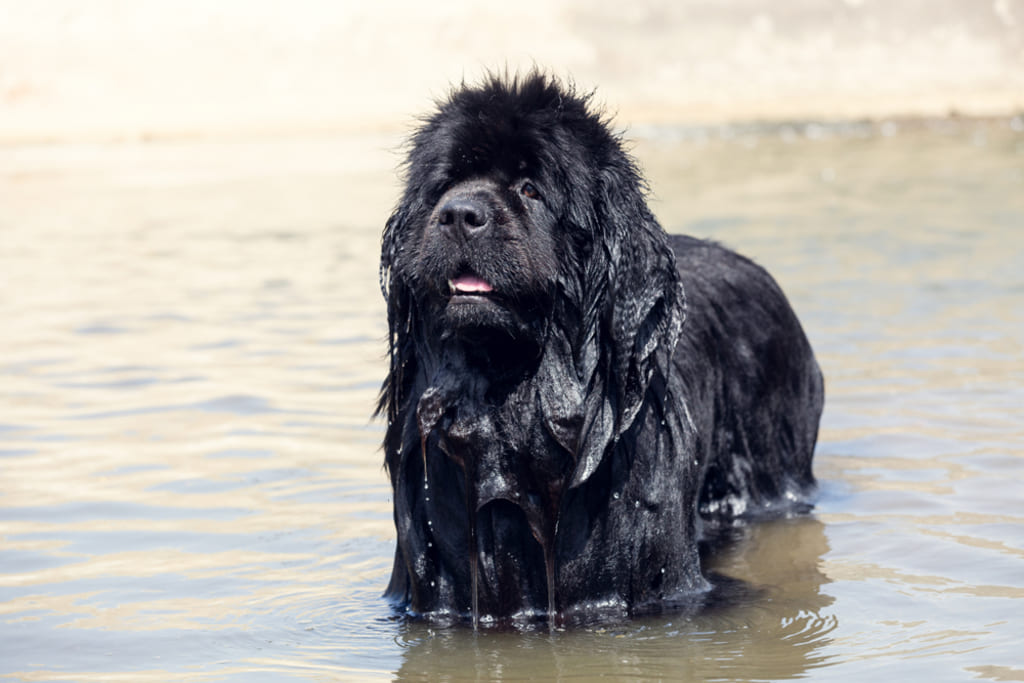
Newfoundland dogs are fantastic family pets, thanks to their sweet and gentle nature, especially around kids and small pets. But keep an eye on the little ones during playtime, as Newfies are big, and you might accidentally bump into them. It’s a good idea to socialize your Newfoundland puppy early with people and other pets to nurture their friendly demeanor.
Although Newfoundland dogs don’t require tons of exercise, they thrive when given an active job, like pulling carts or navigating through an agility course.
In terms of behavior, Newfoundland dogs are confident, smart, and sociable. Due to their history as cart pullers, some may pull on their leash, so early leash training is beneficial. Keep in mind that some Newfies might develop separation anxiety, which you can prevent by providing extra physical and mental stimulation.
Given their rapid growth, especially in size, early obedience training is essential for New Foundland puppies. They’re highly intelligent, making training quite successful. While some can be a bit stubborn, positive reinforcement with lots of treats for good behavior usually works like a charm.
Here are some fun activities to keep them happy:
- Swimming
- Cart pulling
- Hiking
- Flyball
- Agility
Exercise Needs
Make sure your Newfie gets at least 30 minutes to an hour of exercise every day to keep them healthy and happy. They really enjoy long walks, hikes, and, of course, swimming. Engaging them in dog sports like dock diving or activities like search and rescue can provide mental stimulation and keep them physically active while giving them a sense of purpose.
Even though Newfoundland dogs handle cold weather well, their thick coat can make them prone to overheating in hot weather. So, keep outdoor activities short when it’s hot and ensure they always have a cool spot to relax. Indoors, make sure there’s enough space for your Newfie to move around freely during playtime.
Grooming Needs
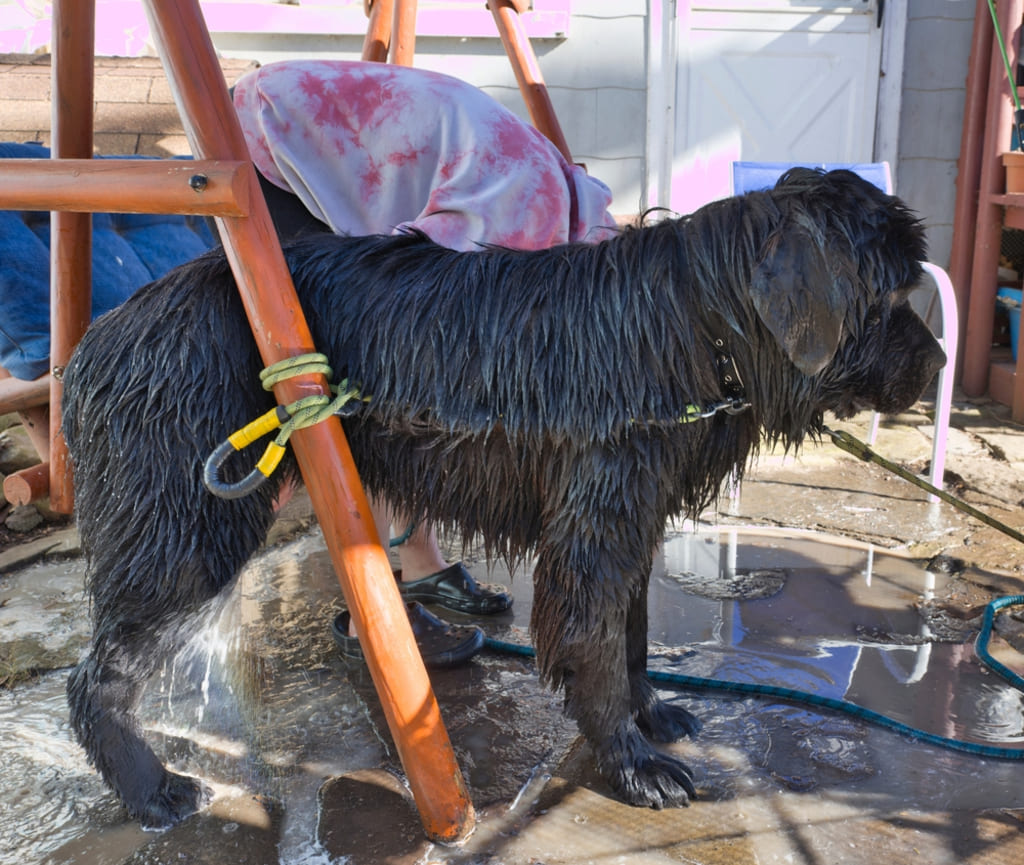
The Newfoundland dog boasts a double coat- a tough, water-resistant outer layer and a soft, dense undercoat. While they shed throughout the year, there are two periods, usually biannually, where shedding intensifies. Proper care is important for a healthy coat, but extensive grooming isn’t a must.
1. Skin Care
Bathing your Newfoundland dog once a month (never more than every two weeks) is ideal. Supplementing with Omega-3 orally helps maintain a healthy skin barrier.
2. Coat Care
Give your Newfie’s long, coarse coat a good brushing at least once a week using a dog comb to remove dead hair and a slicker brush for added shine. Regular brushing also helps minimize fur on your furniture.
3. Ear Care
Due to their floppy ears and long ear canals, Newfoundlands are prone to ear infections. Prevent them with weekly cleaning using a pet-specific ear cleaner. If you notice redness or excessive debris, consult your vet.
4. Eye Care
Newfoundland dogs don’t have special eye care needs. If there’s minor debris around the eyes, a soft, moist cloth can clean it. However, excessive discharge, squinting, or redness may indicate more serious conditions requiring a vet’s attention.
5. Nail and Teeth
Additionally, you’ll need to trim your Newfoundland’s nails about once a month, adjusting based on how quickly they naturally wear down. It’s also recommended to brush your Newfie’s teeth on a daily basis.
To avoid genetic health issues, it is best to select a reputed breeder. While they might charge more than the average Newfoundland dog price, you will get a healthy dog. Top of Form
Are Newfoundlands Hypoallergenic?
If there were such a thing as a hypoallergenic dog breed (technically, there isn’t), the Newfoundland dog would be the complete opposite. These dogs begin shedding as puppies and just keep going.
It’s not just seasonal shedding either – they have significant shedding year-round, happening every day. That’s why, if you have allergies, make sure you think twice before getting a Newfie.
Price
New Foundland puppies for sale from a good breeder usually range from $1,700 to $2,500 on average. If you’re looking for a Newfoundland puppy with exceptional breed lines and a top-notch pedigree, you might find yourself paying between $3,000 and $4,000.
The actual cost of New Foundland puppies for sale can fluctuate based on location and bloodline. Choosing a reputable breeder is important to ensure the pup is healthy.
Life Span
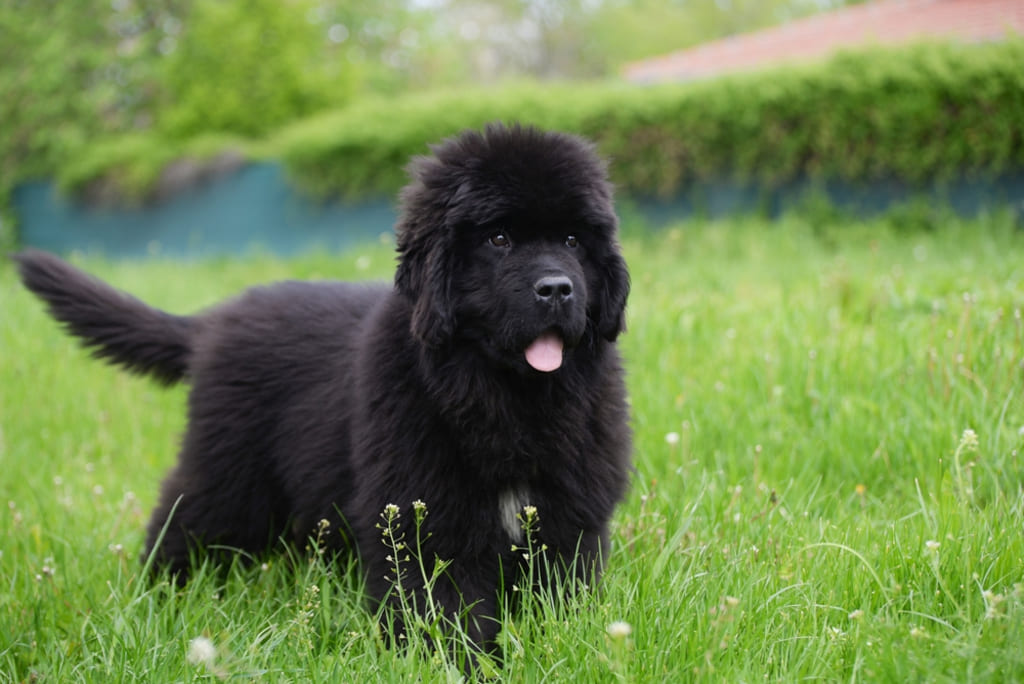
Newfoundland dogs typically live around 10 years, though some might reach only 8. On the flip side, there are cases of Newfoundlands hitting the impressive age of 15. Ensuring your pet gets top-notch nutrition and regular exercise can contribute to extending their lifespan.
FAQs
New Fypoo puppies are a mix of Newfoundland and Poodle breeds.
It is best to buy a New Foundland dog for sale from a reputed breeder. You can search online for a local breeder near your area.
New Fypoo puppies for sale can start from $1,500 and go up to $3000.
Considering the Newfoundland dog price, they are not too expensive, and you can get them around $1,500.
Conclusion
That’s all there is no know about a Newfie. They are a large breed of gentle dogs with amazing personalities and temperaments. These dogs can easily adjust in any family setting.
Newfoundland dogs are loving and loyal and love it when you assign them tasks. They are great swimmers and easily get along with kids and other pets due to their friendly nature.
However, keep in mind that their coat can get really dirty, especially when they spend most of their time outdoors. You also need to regularly brush their coat. Also, they are susceptible to many hereditary health conditions, so choose a reputable breeder.
Explore Further:








